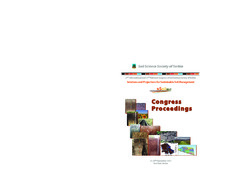Приказ основних података о документу
Water infiltration affected by different land use types and soil texture in temperate climate
| dc.creator | Gajić, Boško | |
| dc.creator | Kresović, Branka | |
| dc.creator | Životić, Ljubomir | |
| dc.creator | Dugalić, Goran | |
| dc.creator | Tomić, Zorica | |
| dc.creator | Sredojević, Zorica | |
| dc.date.accessioned | 2024-01-11T09:26:15Z | |
| dc.date.available | 2024-01-11T09:26:15Z | |
| dc.date.issued | 2017 | |
| dc.identifier.isbn | 978-86-912877-1-9 | |
| dc.identifier.uri | http://aspace.agrif.bg.ac.rs/handle/123456789/6752 | |
| dc.description.abstract | Surface soil hydrological properties like water infiltration and hydraulic conductivity have important consequences for hydrological properties of soils in river basins and their knowledge is needed for sound land management, as well as flood risk prevention. They are very dynamic properties due to varying land use management practices. The objective of this study was to evaluate the effects of two land uses (native meadow and arable) on surface (0–30 cm) infiltration characteristics of a silty clay loam and sandy loam soils at three sites in the Kolubara river valley and the Nišava river valley, respectivelly, with temperate climate, Serbia. A site consisted of two adjacent but different land uses on the same soil types. For each land use, water infiltration rates were measured in triplicate using double ring infiltrometer. Particle size distribution, bulk density and soil organic matter content of the surface soil were determined. Experimental measurements in the field indicated that treatments significantly influenced water infiltration characteristics on both locations. At both site the infiltration rates showed a decrease as a function of elapsed time. Steady state infiltration rate and cumulative infiltration of sandy loam-textured soils under the meadows were much lower than that for the arable soils. By contrast, the infiltration capacity and cumulative infiltration of silty clay loam soils under the meadows was significantly (P < 0.05) higher compared to arable soils. Increase in infiltration capacity of arable soils were related to decrease in bulk density. In addition, in tilled sandy loam soil infiltration was much higher than in silty clay loam soil. However, infiltration in a silty clay loam under meadow was lower compared with sandy loam soil. According to the results of our study it could be concluded that the land use change infiltration properties of surface soil and consequently may alter the water balance of the area by changing the amount of surface runoff and soil water retention. Knowledge of how management practices affect infiltration capacity can aid growers in reducing soil quality and degradation. | sr |
| dc.language.iso | en | sr |
| dc.publisher | Srpsko društvo za proučavanje zemljišta | sr |
| dc.relation | info:eu-repo/grantAgreement/MESTD/MPN2006-2010/143009/RS// | sr |
| dc.rights | openAccess | sr |
| dc.rights.uri | https://creativecommons.org/licenses/by/4.0/ | |
| dc.source | 2nd International and 14th National Congress of Soil Science Society of Serbia "Solutions and Projections for Sustainable Soil Management", Novi Sad, Serbia | sr |
| dc.subject | vegetation change | sr |
| dc.subject | meadow | sr |
| dc.subject | arable land | sr |
| dc.subject | Fluvisols | sr |
| dc.subject | surface soil | sr |
| dc.title | Water infiltration affected by different land use types and soil texture in temperate climate | sr |
| dc.type | conferenceObject | sr |
| dc.rights.license | BY | sr |
| dc.citation.epage | 234 | |
| dc.citation.spage | 228 | |
| dc.identifier.fulltext | http://aspace.agrif.bg.ac.rs/bitstream/id/25700/bitstream_25700.pdf | |
| dc.identifier.rcub | https://hdl.handle.net/21.15107/rcub_agrospace_6752 | |
| dc.type.version | publishedVersion | sr |


